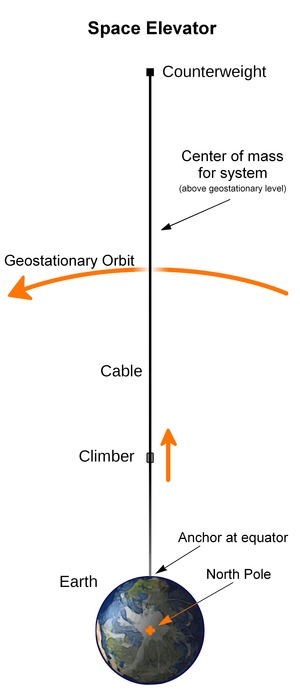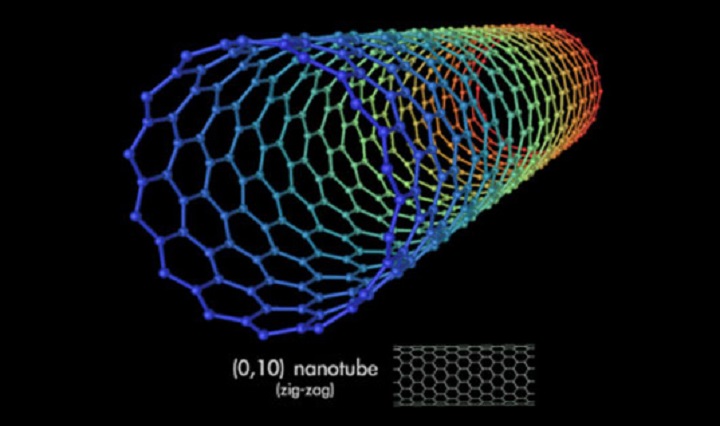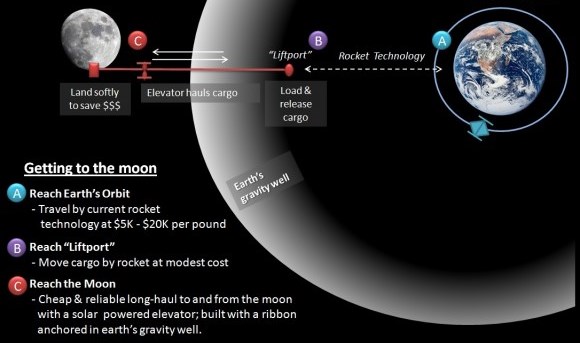
Imagine if you will a long tether made of super-tensile materials running 100,000 km from the Earth and reaching a platform in geostationary orbit. Now imagine that this tether is a means of shipping people and supplies into orbit, forever removing the need for rockets and shuttles going into space. For decades, scientists and futurists have been dreaming about the day when a “Space Elevator” would be possible. And according to a number of proposed designs and reports, that day may be coming in the near future.
First proposed by Russian scientist Yuri N. Artsutanov in 1959, the concept is based on the idea of a tensile structure that uses a geostationary satellite in orbit as its base from which to deploy the structure downward. While a counterweight would be extended from this satellite away from Earth, a cable would extend from geostationary orbit (GSO) to the surface of Earth, keeping the cable constantly over the same spot on the surface of our planet.

In addition to being a bold feat of engineering, the concept offers a wide range of benefits. For starters, experts have claimed that a space elevator could signal the end of Earth-based rockets which are hugely expensive and dangerous. Compared to space shuttles, which cost about $22,000 per kilogram to take cargo into space, the Space Elevator - which relies on rocket-powered robot cars that zip along the tether - could do it for as little as $200 to $500 (depending on who's estimates you consider).
It’s also believed that having one operational could help solve the world’s power problems by delivering huge amounts of solar power arrays into orbit where they would be able to soak up the sun twenty-four hours a day and beam the energy back to Earth.
In addition, it would be a major shot in the arm for exploratory missions to other planets in our Solar System, since spacecraft could be housed in orbit and wouldn't have to be launched from Earth. Crews and supplies could simply be shuttled to and from orbit before the vessel broke off to head into space, and returning ships could simply dock with the platform rather than have to land Earthside.
It would also be a boon for space tourism. Commercial space companies are already talking about sending people to the Moon for a getaway. Having a "transfer point" in orbit would make that dream so much simpler, and could open for commercial trips to Mars and even beyond.
But of course, there are a few barriers to constructing such a marvel of engineering. For one, it would be an extremely expensive venture, and beyond the capacity of any one nation to build. Second, there are issues of ownership when it comes to such a device. While space may be neutral territory as far as national sovereignty is concerned, Earth is not. As a result, the elevator would need to be built in neutral territory and protected/administered by an international body to ensure that no one had exclusive access to it.
And last, but certainly not least, there's the issue of the tether itself. Ever since it was first proposed decades ago, scientists have been marred by the fact that no known material possessed the tensile strength needed to make a space elevator feasible. However, the invention of carbon nanotubes around the turn of the century has led to a revitalization. Believing that the high strength of these materials might make an "orbital skyhook" feasible, engineer David Smitherman of NASA put together a workshop at the Marshall Space Flight Center in 2000 and invited many scientists and engineers to participate.

Their findings were published in an article titled “Space Elevators: An Advanced Earth-Space Infrastructure for the New Millennium”. Another American scientist, Bradley C. Edwards, also suggested using nanotubes to create a 100,000 km (62,000 mi) paper-thin cable that would be shaped like a ribbon instead of circular. This, he claimed, would make the tether more resistant to impacts from meteoroids. The NASA Institute for Advanced Concepts began supporting Edwards’ work, allowing him to expand on it and plan how it would work in detail. Since that time, numerous proposals have been made by both the private and public sectors, and have been spurred on by additional advancements in engineering.
For starters, in March of 2005, NASA announced its own incentive program, known as the Centennial Challenges program, which has since merged with the Spaceward Foundation and upped the total value of their cash prizes to US$400,000. In that same year, the LiftPort Group - a private aerospace company - began producing carbon nanotubes for industrial use, with the goal of using their profits as capital for the construction of a 100,000 km (62,000 mi) space elevator.
In 2008, the Japanese firm known as the Space Elevator Association, chaired by Shuichi Ono, announced plans to build a Space Elevator for the projected price tag of a trillion yen ($8 billion). Though the cost is substantially low, Ono and his peers claimed that Japan’s role as a leader in the field of engineering could resolve the technical issues at the price they quoted. In 2011, the first European Space Elevator Challenge (EuSEC) to establish a "climber structure" (aka. a space elevator) took place in August.

In 2012, the Obayashi Corporation of Japan announced that it would build a space elevator by 2050 using carbon nanotube technology. Their detailed plan called for a 96,000 long tether, supported by a counterweight, that could hold a 30-passenger climber that would travel 200 km/h, reaching GSO after a 7.5-day trip. However, no cost estimates, finance plans, or other specifics have been made at this point.
And in March of this year, the International Academy of Astronautics (IAA) issued a 350-page report that laid out a detailed case for a space elevator as early as 2035. The central argument of the paper — that we should build a space elevator as soon as possible — is supported by a detailed accounting of the challenges associated with doing so. The possible pay-off is as simple: a space elevator could bring the cost-per-kilogram of launch to geostationary orbit from $20,000 to as little as $500. Not only would be it useful for deploying satellites, it would also be far enough up Earth’s gravity well to be able to use it for long-range missions.
Projecting current research in carbon nanotubes and similar technologies, the IAA estimates that a pilot project could plausibly deliver packages to an altitude of 1000 kilometers (621 miles) as soon as 2025. With continued research and the help of a successful LEO elevator - low Earth orbit, i.e. between 160 and 2000 km (99 -1200 mi) - they predict a 100,000-kilometer (62,137-mile) successor will stretch well past geosynchronous orbit just a decade after that.

And in October of this year, Liftport finally announced its intention to build an elevator that would reach from the Moon to a distance of 238,000 km towards the Earth. Similar to a Space Elevator, the concept of a "Lunar Elevator" is a bit more practical because of the Moon's low gravity. In addition, the Lunar Elevator would use the Earth's own gravitational pull to stabilize the tether, rather than the circumferential force caused by the Earth's rotation.
Liftport CEO Michael Laine claims that the Moon Elevator can be built off-the-shelf, with readily available technology. A prototype could be built and deployed within a decade for as little as $800 million, he claims. And to demonstrate their idea, they are working on a proof of concept demonstration that will see a robot climb the tallest freestanding human structure in existence. This structure will consist of three large helium balloons held together on a tripod and a giant spool of Vectran fiber that will be able to support 635 kilograms (1,400 pounds) and withstand strong winds.
Most recently, a research team working out of Penn State University has created something that is sure to give all plans for a Space Elevator a shot in the arm. Led by chemistry professor John Badding, the team has created a “diamond nanothread” – a thread composed of carbon atoms that measures one-twenty-thousands the diameter of a single strand of a human hair - and which may prove to be the strongest man-made material in the universe.

At the heart of the thread is a structure of hexagonal rings of bonded carbon atoms that make up diamonds, the hardest known mineral in existence. That makes these nanothreads potentially stronger and more resilient than the most advanced carbon nanotubes, which would make it a prime candidate for building the tether.
Given the challenges associated with building a space elevator, it is unclear when such a device may finally be built. In addition to the technical requirements and gross financial commitments, the need for international cooperation presents quite the challenge as well. But given the rapidly advancing state of materials science, the benefits of having one up and running this century, and its importance to the long-term goals of space exploration and research, it is not unrealistic to assume that one could very well exist by 2050 - if not sooner.
Moreover, countless researchers, planners, futurists, and speculative thinkers from around the world agree: humanity's future lies in space. With our very survival dependant on settling the Moon, Mars, and exploring the depths of the Milky Way, it may not be a question of whether or not we can afford to build one, but whether we can afford not to.
Be sure to check out this NASA animation of a Space Elevator concept in action:
Sources:
- www.cnet.com/news/new-diamond-nanothreads-may-make-space-elevator-a-reality/
- science.psu.edu/news-and-events/2014-news/Badding9-2014
- motherboard.vice.com/en_ca/read/one-companys-plan-to-build-a-space-elevator-to-the-moon?trk_source=nav
- www.extremetech.com/extreme/176625-60000-miles-up-geostationary-space-elevator-could-be-built-by-2035-says-new-study
- www.gizmag.com/obayashi-space-elevator/21587/
- io9.com/5984371/why-well-probably-never-build-a-space-elevator
- www.forbes.com/sites/alexknapp/2012/08/28/liftport-is-kickstarting-a-space-elevator-for-the-moon/
Image Credits:
- Diamond Nanothread: John Badding Lab/Penn State University








